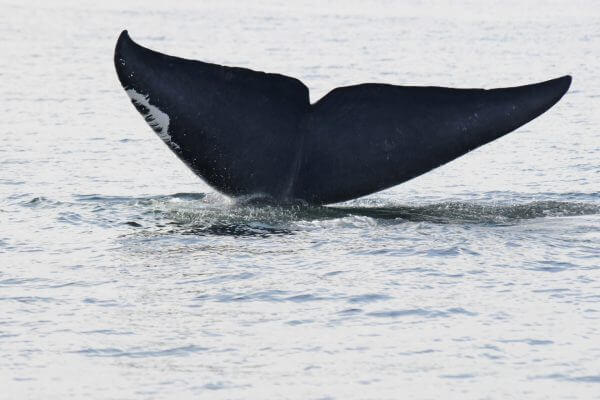“In 51 years of watching whales, I’ve never seen that!” At the end of the line, the voice of our observer trembles with excitement. Off Pointe-des-Monts, on August 12 and 14, he witnessed feeding scenes of one group of 12 fin whales west of his boat and 7 more fin whales to the east. Also in the area are between thirty and forty minke whales, large numbers of porpoises as well as seals. What’s been attracting so many species and so many individuals? Food, of course! The water appears to be bubbling at the surface with all the mackerel and sand lance. He also sees a school measuring about 10 metres in diameter composed of fish weighing about 15 kilos each. The fish zoom by, their tapered fins splitting the water surface for a few seconds before disappearing. Did he just witness a school of Atlantic bluefin tuna? Maybe! A similar observation is reported off the coast of Anticosti Island.
Between Rivière-au-Tonnerre and Mingan, the Mingan Island Cetacean Study (MICS) team crosses paths with 20 humpbacks – including Irisept, Paloma and Helmet – and about 15 fin whales. On August 14, between Anticosti and the north shore of the St. Lawrence, harbour porpoises, minke whales, twenty or so basking sharks and about fifteen fin whales On August 11, off the coast of Colombier, René Roy photographs the female Jaw-Breaker accompanied by a calf that, according to MICS researcher and director Richards Sears, is about to be weaned. This observation establishes a new record: five calves observed in a single season in the St. Lawrence, which is unheard of!
In Portneuf-sur-Mer, Mériscope’s Dany Zbinden also bumps into Jaw-Breaker and her calf, as well as three other blue whales, including Chameau. He also observes two fin whales and a number of porpoises, but no minke whales, the species he studies! Nevertheless, on August 12, the Mériscope crew observes a giant feast around Prince Shoal off the coast of Tadoussac, where no fewer than 45 minke whales are feeding. No biopsies can be taken; to perform such an operation, the targeted individual must be tracked for 45 minutes before the biopsy and 45 minutes after, but with so many minke whales together, it’s impossible to follow just one!
Not far from Matane, on August 11, René Roy also encounters a group of eight belugas that blend into the wave crests.
On August 12, off Franquelin, six minke whales, one of which comes close to shore, are seen feeding. A large tail appears above the waves, but given the distance of the animal, it’s hard to say whether it is a humpback or a blue whale. An observer on the water between Godbout and Franquelin reports four fin whales and several seals that same day.
And, in Les Escoumins, since August 12, nearly a dozen blue whales captivate all those who lay eyes on them. New humpback whales are also seen, including H855, the calf born to Tic Tac Toe in 2017.
Click on the whale or the seal icon to find out more about the corresponding observation (specie, number of individuals, info, pictures). To enlarge the map, click on the top right corner icon.
To see the list of the observations, click on the top left corner.
This map represents an order of magnitude rather than a comprehensive survey.
Legend for the whales
Light grey: Beluga
Dark grey: Fin Whale
Black: Minke Whale
Light blue: Humpback Whale
Dark blue: Blue Whale
Violet: Right Whale
Red: Narwhal
Yellow: Killer Whale
Legend for the dolphins
Brown: Harbour Porpoise
Light grey: White-sided Dolphins
Legend for the seals
Grey: Grey Seal
Brown: Harp Seal
Kaki: Harbour Seal
Legend for the sharks
Light grey: Basking Shark
Legend for the turtles
Dark blue: Leatherback Sea Turt





